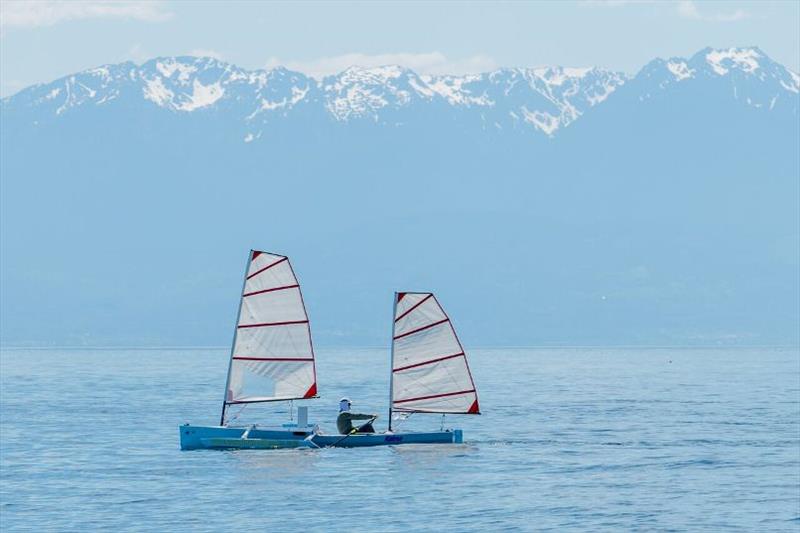
Welcoming the Race to Alaska's class of 2019
by David Schmidt 17 Apr 2019 03:00 AEST
April 16, 2019

Team Kairos – Race to Alaska 2018 © Katrina Zoe Norbom / racetoalaska.com
If you're anything like me, April 15 isn't your favorite day. Sure, income taxes happen, and they need to be paid in order to help finance a functional society, but strange is the sailor who would rather cut a fat check to the IRS than scribbling a similar payment to his or her sailmaker. Fortunately, your friends at the Race to Alaska (R2AK) worked hard yet again to instil a bit of excitement into a day that many of us rue by accepting the final entries for the 2019 edition of this human-powered adventure race at the stroke of midnight on Monday.
For racers, the class of 2019 is now established (baring last-minute drop-outs); for the rest of us, now is the time to start reading up on the teams, picking your favorites, and cheering all contestants onwards as they prepare for a race that can only be described as tough, both mentally and physically.
For anyone just now reading about the R2AK, the event was dreamed up at the 2014 Port Townsend Wooden Boat Festival, in Port Townsend, Washington, and is run by the good folks at the Northwest Maritime Center. The conversation focused on the concept of a "fair means" race to Alaska, starting in Port Townsend and following the inside passage up between Vancouver Island and mainland British Columbia, before punching into the open waters of Queen Charlotte sound and gunning for the finishing line in Ketchikan. (Yes, pints were involved.)
The punchline? No engines. Period.
Racers are free to select any steed they like, so long as the vessel is entirely human-powered and free of an internal combustion engine. This, of course, places a huge emphasis on the ability to sail, row or pedal, and it also makes one's choice of vessels a critical decision. Moreover, it reduces reliance on electronic navigation and weather-routing services, therefore placing even greater importance on preparation and vessel selection.
The first answer to the race's riddle as to the fastest horse for the course was a trimaran (2015), followed by a turbo-charged catamaran (2016), followed by a wicked-up trimaran (2017), followed last year by a monohull. While this nicely covers the gamut of yacht design, it also hoists more question marks than it douses.
Race wisdom holds that the first team to make it through Seymour Narrows - a spot roughly two thirds of the way up Vancouver Island's inside passage (just north of Vancouver's Campbell River) where the peak tide can hit 15-16 knots - will most likely be the first to Ketchikan. This, of course, places a massive premium on each team's ability to crank hard through this 3.1-mile stretch of brine, irrespective of the apparent airs.
Teams can make stops and can get help and supplies along the way, so long as all resources used are publicly available (read: general stores are in; dedicated supply vans are out), and teams are welcome to camp on the beach... so long as sailors have cans of bear spray ready, as sailing in the Pacific Northwest isn't exactly like day sailing on Long Island Sound.
All sailors, irrespective of the number of hulls they elect to sail north with, must respect the fact that the water is cold, hypothermia is never more than a few minutes away, and there's a ton of heavy metal (commercial shipping) contending for piloting bandwidth. Moreover, north of Vancouver Island, sailors need to be prepared for a wilderness experience, coupled with usually nasty conditions.
The 2019 edition of the R2AK will start on the waters off of Port Townsend, Washington on Monday, June 3, and will take racers first to Victoria, B.C., a 40-mile shakedown cruise that serves as Leg 1 (read: the race's "proving ground"), before pushing on a few days later to Ketchikan.
Not surprisingly, the 2019 fleet looks a lot like similar classes in the sense that sailors are still arm-wrestling over the best tool for the job. In addition to the usual suspects (e.g. Melges 24s, F-24s, F-27s, and F-31s), interesting entrants include Team Auklet's Bolger Glasshouse Chebacco, Team Pear Shaped Racing's Chris Cochrane 10.6m custom trimaran, Team Solveig's Norwegian faering rowboat, Team Ziska: Sail Like A Luddite's Lancashire Nobby, Team Extremely Insane's Airboard SUP, and Team Holopuni's Hawaiian outrigger sailing canoe.
And while a Hobie Adventure Island is a proven R2AK design, Nigel Davies officially gets our vote for the coolest name of 2019 with his Team Hobie-1-Kenobie entry. (May the Force be with you, Mr. Davies.)
If this seems like an eclectic fleet, welcome to the R2AK. And if racing to Alaska sans an engine or any fast and easy escape hatch sounds like a darn good time, remember, your next Tax Day could be filled with serious excitement over an upcoming adventure, rather than sour tears over a drained bank account.
Sail-World.com wishes all 2019 R2AK entrants good luck as they ready their steeds and make their final preparations for what can only be described as one of North America's wildest sailboat races.
May the four winds blow you safely home.
David Schmidt
Sail-World.com North American Editor